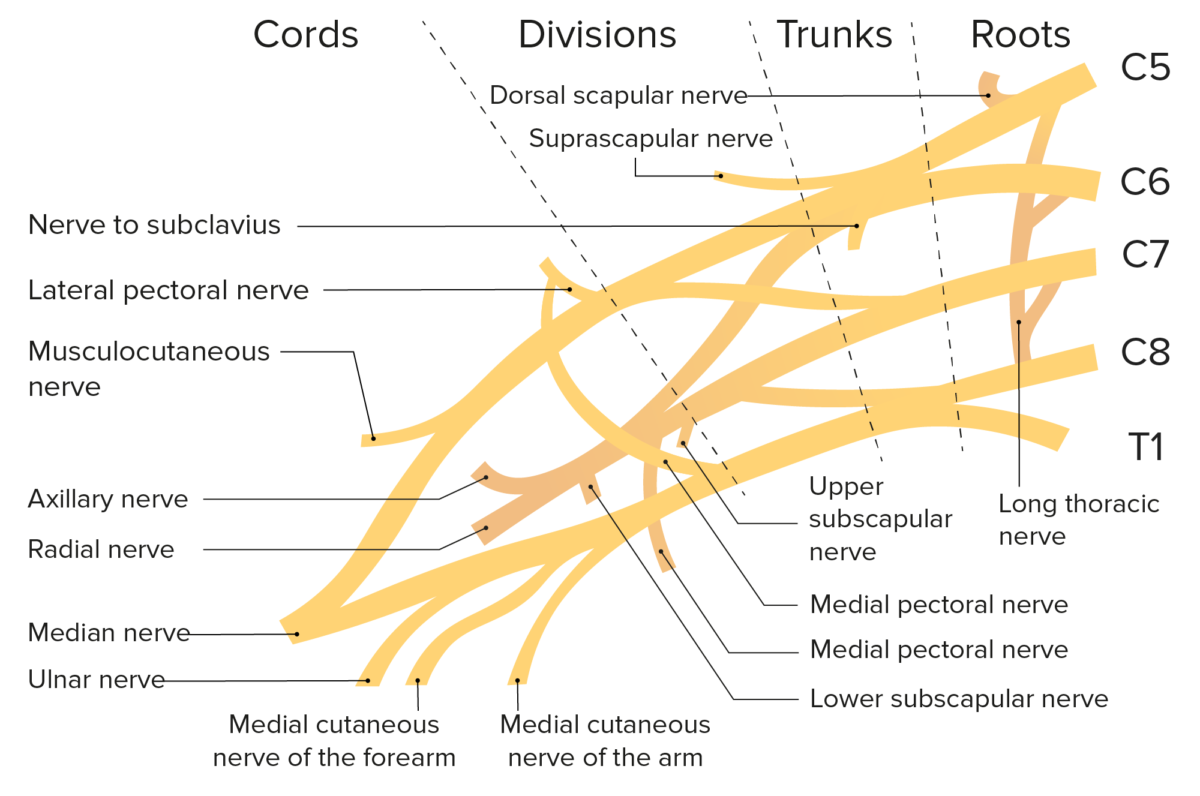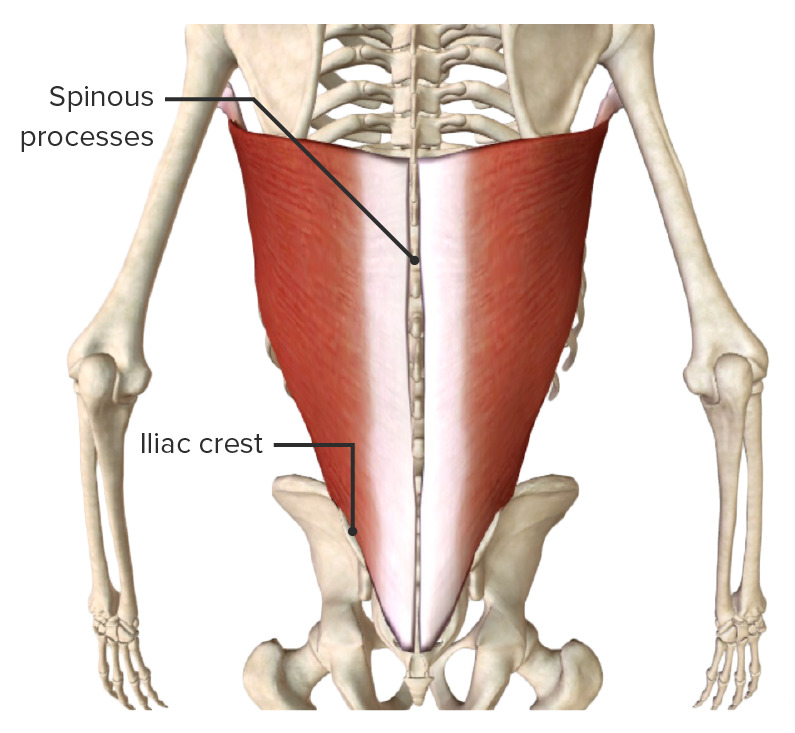There are many etiologies of peripheral nerve injuries in the cervicothoracic region. The injuries commonly involve the phrenic nerve Phrenic nerve The motor nerve of the diaphragm. The phrenic nerve fibers originate in the cervical spinal column (mostly C4) and travel through the cervical plexus to the diaphragm. Diaphragm: Anatomy, the suprascapular nerve Suprascapular nerve Axilla and Brachial Plexus: Anatomy, the dorsal scapular nerve Dorsal scapular nerve Axilla and Brachial Plexus: Anatomy, the long thoracic nerve Long thoracic nerve Axilla and Brachial Plexus: Anatomy, or the thoracodorsal nerve Thoracodorsal nerve Axilla and Brachial Plexus: Anatomy. The nerves arise from the cervical plexus and brachial plexus. Causes of injury vary and may include trauma, compression Compression Blunt Chest Trauma, nerve entrapment, stretch or traction from repetitive movement, infection, surgical injury, or metabolic causes. Clinical presentation depends upon the motor Motor Neurons which send impulses peripherally to activate muscles or secretory cells. Nervous System: Histology and sensory Sensory Neurons which conduct nerve impulses to the central nervous system. Nervous System: Histology innervation of the affected nerves. Diagnosis is mostly clinical but may also be confirmed with imaging or electrodiagnostic studies. Depending on the specific injury, management may be either surgical or conservative ( physical therapy Physical Therapy Becker Muscular Dystrophy and avoidance of precipitating movements).
Last updated: Jan 13, 2023
Nerve roots emerge from the spinal cord Spinal cord The spinal cord is the major conduction pathway connecting the brain to the body; it is part of the CNS. In cross section, the spinal cord is divided into an H-shaped area of gray matter (consisting of synapsing neuronal cell bodies) and a surrounding area of white matter (consisting of ascending and descending tracts of myelinated axons). Spinal Cord: Anatomy at the C1 level and below.
C1 through C4 nerve roots close to the spinal cord Spinal cord The spinal cord is the major conduction pathway connecting the brain to the body; it is part of the CNS. In cross section, the spinal cord is divided into an H-shaped area of gray matter (consisting of synapsing neuronal cell bodies) and a surrounding area of white matter (consisting of ascending and descending tracts of myelinated axons). Spinal Cord: Anatomy merge to form the cervical plexus.
Cutaneous branches of the cervical plexus innervate the skin Skin The skin, also referred to as the integumentary system, is the largest organ of the body. The skin is primarily composed of the epidermis (outer layer) and dermis (deep layer). The epidermis is primarily composed of keratinocytes that undergo rapid turnover, while the dermis contains dense layers of connective tissue. Skin: Structure and Functions, transmitting sensory Sensory Neurons which conduct nerve impulses to the central nervous system. Nervous System: Histology information:
Motor Motor Neurons which send impulses peripherally to activate muscles or secretory cells. Nervous System: Histology branches of the cervical plexus innervate muscles of the shoulders and neck Neck The part of a human or animal body connecting the head to the rest of the body. Peritonsillar Abscess:

Cervical plexus:
C1 through C4 nerve roots close to the spinal cord merge to form the cervical plexus.
C5 through T1 nerve roots merge to form the brachial plexus, which travels from the spinal cord Spinal cord The spinal cord is the major conduction pathway connecting the brain to the body; it is part of the CNS. In cross section, the spinal cord is divided into an H-shaped area of gray matter (consisting of synapsing neuronal cell bodies) and a surrounding area of white matter (consisting of ascending and descending tracts of myelinated axons). Spinal Cord: Anatomy into the cervicoaxillary canal and the armpit. The nerves are divided into regions called trunks, divisions, cords, branches, and nerves.

Schematic of the brachial plexus and the branches of the brachial plexus
Image by Lecturio.The phrenic nerve Phrenic nerve The motor nerve of the diaphragm. The phrenic nerve fibers originate in the cervical spinal column (mostly C4) and travel through the cervical plexus to the diaphragm. Diaphragm: Anatomy arises from anterior rami of C3, C4, and C5 nerve roots and provides motor Motor Neurons which send impulses peripherally to activate muscles or secretory cells. Nervous System: Histology innervation to the diaphragm Diaphragm The diaphragm is a large, dome-shaped muscle that separates the thoracic cavity from the abdominal cavity. The diaphragm consists of muscle fibers and a large central tendon, which is divided into right and left parts. As the primary muscle of inspiration, the diaphragm contributes 75% of the total inspiratory muscle force. Diaphragm: Anatomy:
Clinical features vary and depend upon the extent of the injury. Clinical features depend on whether nerves are injured bilaterally or unilaterally:

Unilateral diaphragmatic paralysis showing elevated hemidiaphragm
Image: “Chest X-Ray on admission” by Department of medicine (ward 45), the National hospital of Sri Lanka, Regent Street, Colombo 00800, Sri Lanka. License: CC BY 2.0
Radiograph showing bilateral diaphragmatic paralysis
Image: “(a) Frontal chest radiograph during initial presentation. (b) Lateral chest radiograph during initial presentation” by Department of Respiratory Medicine, Maastricht University, Medical Centre, Maastricht, 6200 MD, Netherlands. License: CC BY 4.0The suprascapular nerve Suprascapular nerve Axilla and Brachial Plexus: Anatomy arises from the upper trunk of the brachial plexus (C5, C6) and gives:
Injury most commonly occurs at the suprascapular notch, the spinoglenoid notch, or the superior transverse scapular ligament.

The path of the suprascapular nerve:
The suprascapular nerve is most commonly injured at the suprascapular notch, the spinoglenoid notch, or the superior transverse scapular ligament.
The dorsal scapular nerve Dorsal scapular nerve Axilla and Brachial Plexus: Anatomy arises from the anterior ramus of the C5 nerve root:
Dorsal scapular nerve Dorsal scapular nerve Axilla and Brachial Plexus: Anatomy syndrome is caused by nerve compression Nerve Compression Brachial Plexus Injuries:

Scapula winging:
A winged scapula can result from dorsal scapular nerve injury.
Conservative management is preferred. Surgery is reserved for individuals with severe injury refractory to nonoperative means:
The long thoracic nerve Long thoracic nerve Axilla and Brachial Plexus: Anatomy is a pure motor Motor Neurons which send impulses peripherally to activate muscles or secretory cells. Nervous System: Histology nerve, which travels inferiorly along the serratus anterior muscle Serratus anterior muscle Chest Wall: Anatomy:
Clinical features are generally minimal. Classic findings and symptoms may be present in more severe cases:
Thoracodorsal nerve Thoracodorsal nerve Axilla and Brachial Plexus: Anatomy:
Thoracodorsal nerve Thoracodorsal nerve Axilla and Brachial Plexus: Anatomy injury can occur from surgical injury during axillary dissection for breast cancer Breast cancer Breast cancer is a disease characterized by malignant transformation of the epithelial cells of the breast. Breast cancer is the most common form of cancer and 2nd most common cause of cancer-related death among women. Breast Cancer.

Latissimus dorsi muscle (part of the superficial or extrinsic posterior axioappendicular muscles)
Image by BioDigital, edited by Lecturio